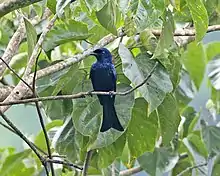| Balicassiao | |
|---|---|
 | |
| Scientific classification | |
| Domain: | Eukaryota |
| Kingdom: | Animalia |
| Phylum: | Chordata |
| Class: | Aves |
| Order: | Passeriformes |
| Family: | Dicruridae |
| Genus: | Dicrurus |
| Species: | D. balicassius |
| Binomial name | |
| Dicrurus balicassius (Linnaeus, 1766) | |
| Synonyms | |
|
Corvus balicassius Linnaeus, 1766 | |
The balicassiao (Dicrurus balicassius) is a species of passerine bird in the family Dicruridae. It is endemic to the Philippines.
Its natural habitat is subtropical or tropical moist lowland forests.
Description
Medium size, sexes alike, races differ in size, abraensis is the largest, and in being all black abraensis and balicassius or having white lower breast and belly mirabilis.
Taxonomy
In 1760 the French zoologist Mathurin Jacques Brisson included a description of the balicassiao in his Ornithologie based on a specimen collected in the Philippines. He used the French name Le choucas des Philippines and the Latin Monedula Philippensis.[2] Although Brisson coined Latin names, these do not conform to the binomial system and are not recognised by the International Commission on Zoological Nomenclature.[3] When in 1766 the Swedish naturalist Carl Linnaeus updated his Systema Naturae for the twelfth edition, he added 240 species that had been previously described by Brisson.[3] One of these was the balicassiao. Linnaeus included a brief description, coined the binomial name Corvus balicassius and cited Brisson's work.[4] The specific name balicassius is from Balicasiao, the Cebuano word for this bird.[5] This species is now placed in the genus Dicrurus that was introduced by French ornithologist Louis Pierre Vieillot in 1816.[6]
References
- ↑ BirdLife International (2016). "Dicrurus balicassius". IUCN Red List of Threatened Species. 2016: e.T22706993A94101710. doi:10.2305/IUCN.UK.2016-3.RLTS.T22706993A94101710.en. Retrieved 12 November 2021.
- ↑ Brisson, Mathurin Jacques (1760). Ornithologie, ou, Méthode contenant la division des oiseaux en ordres, sections, genres, especes & leurs variétés (in French and Latin). Vol. 2. Paris: Jean-Baptiste Bauche. pp. 31–32, Plate 2 fig 1. The two stars (**) at the start of the section indicates that Brisson based his description on the examination of a specimen.
- 1 2 Allen, J.A. (1910). "Collation of Brisson's genera of birds with those of Linnaeus". Bulletin of the American Museum of Natural History. 28: 317–335. hdl:2246/678.
- ↑ Linnaeus, Carl (1766). Systema naturae : per regna tria natura, secundum classes, ordines, genera, species, cum characteribus, differentiis, synonymis, locis (in Latin). Vol. 1, Part 1 (12th ed.). Holmiae (Stockholm): Laurentii Salvii. p. 157.
- ↑ Jobling, J.A. (2018). del Hoyo, J.; Elliott, A.; Sargatal, J.; Christie, D.A.; de Juana, E. (eds.). "Key to Scientific Names in Ornithology". Handbook of the Birds of the World Alive. Lynx Edicions. Retrieved 20 June 2018.
- ↑ Vieillot, Louis Pierre (1816). Analyse d'une Nouvelle Ornithologie Élémentaire (in French). Paris: Deterville/self. p. 41.
